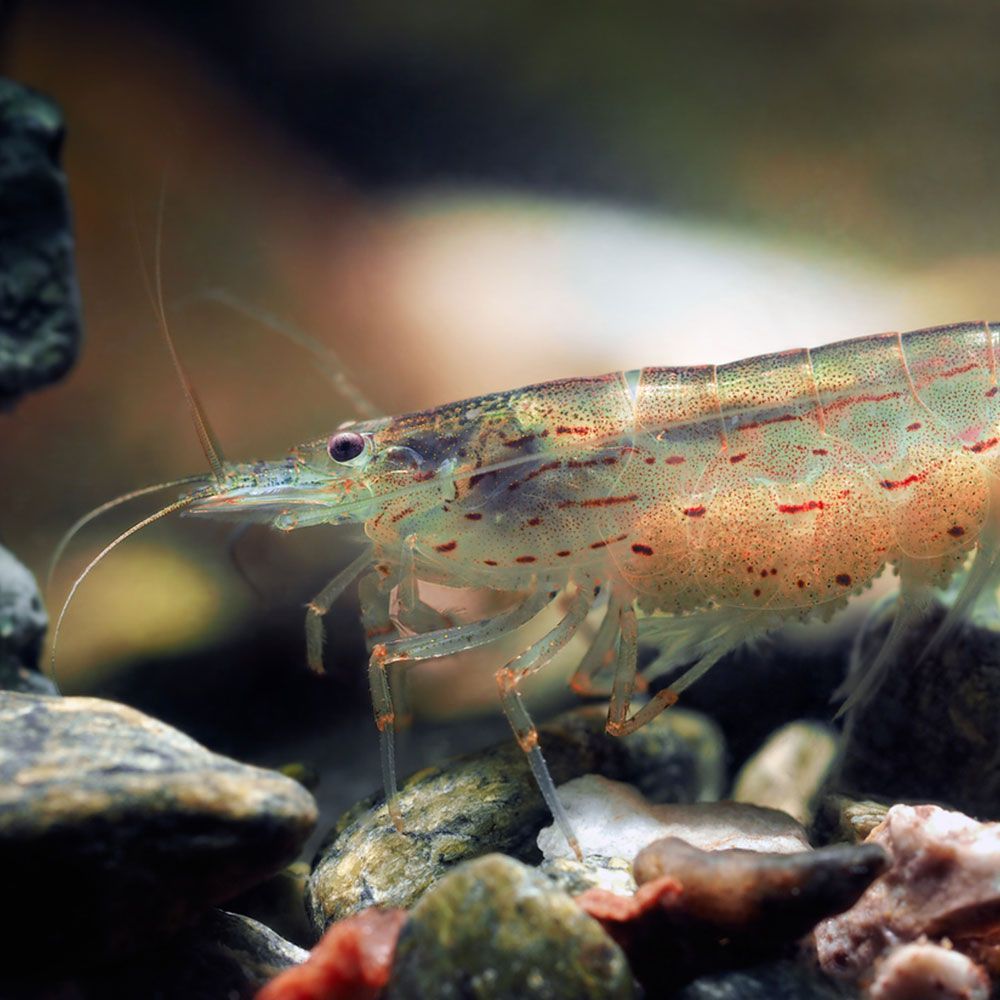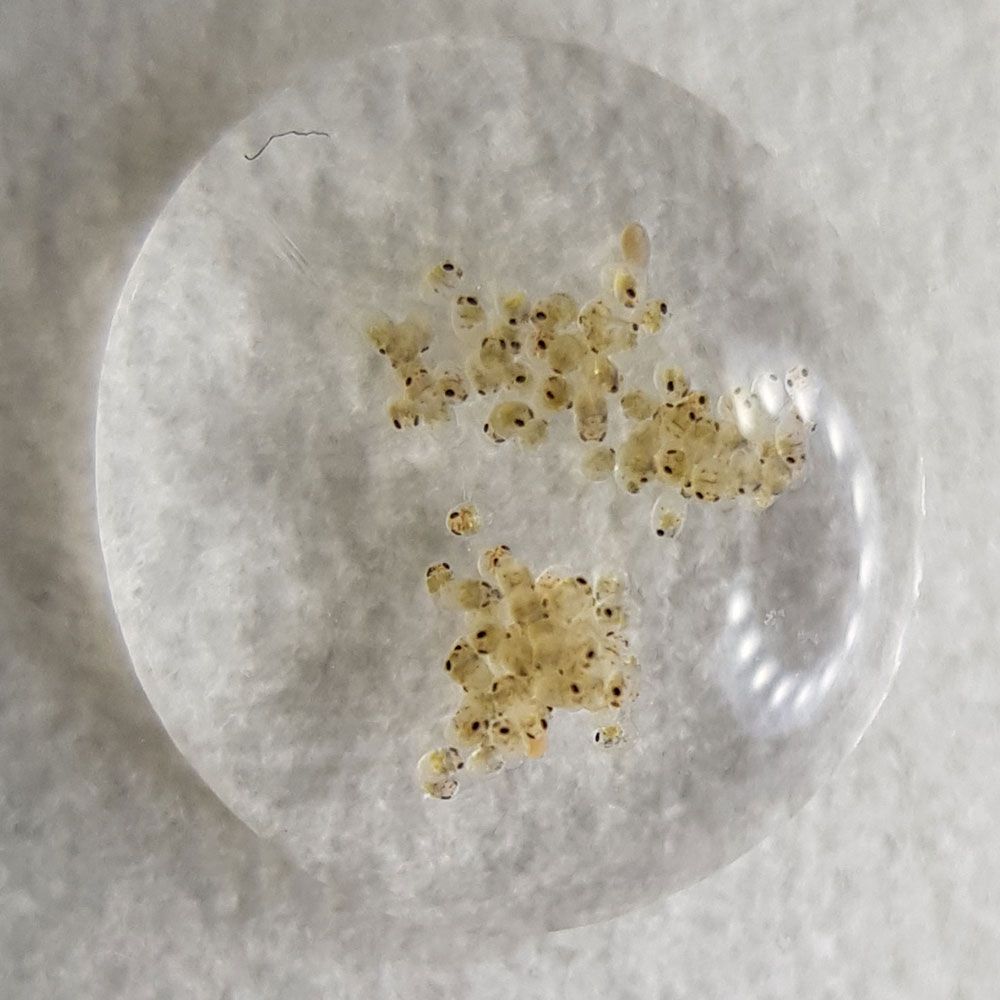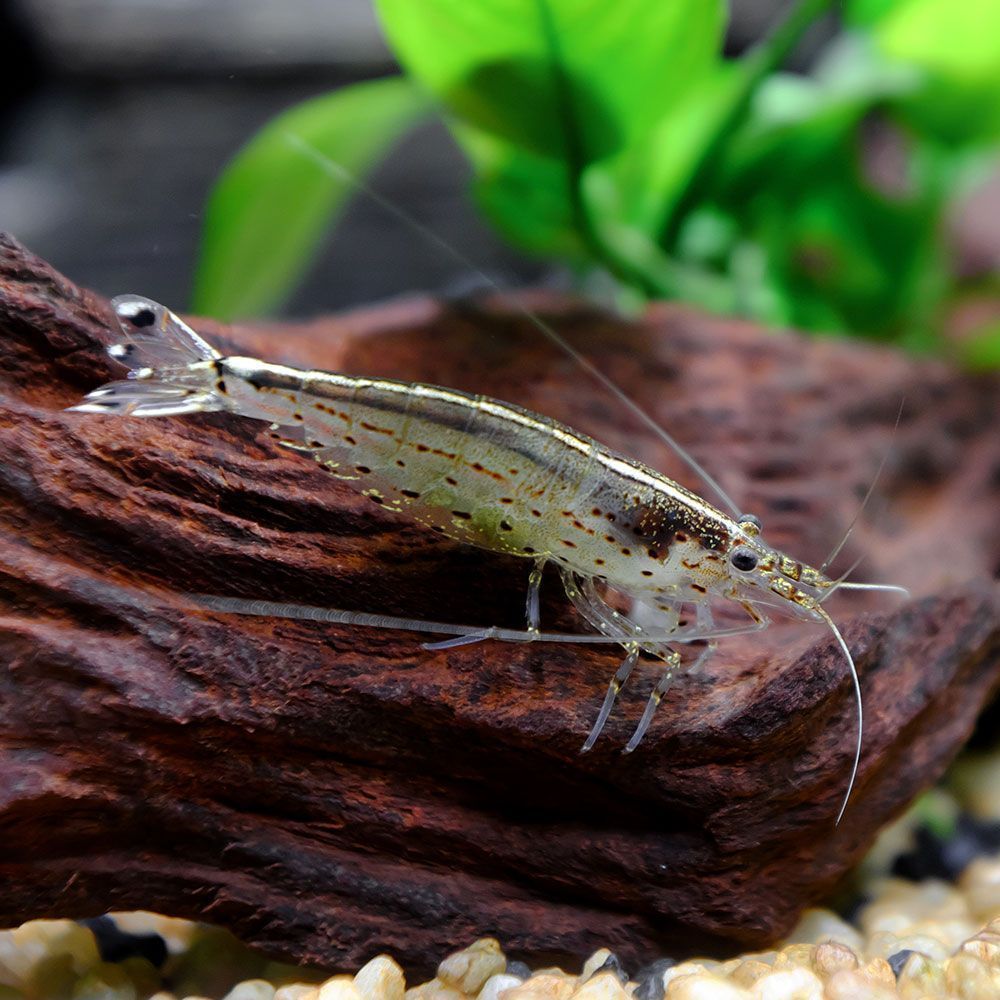If you want to add a cute little invertebrate to your freshwater tank, you should definitely consider Amano shrimp.
It’s a favorite among aquarists because of its low-maintenance nature. The shrimp can also keep minimal algal growth in your tank under control with exceptional cleaning skills.
Moreover, if you’re up for a new challenge in your fishkeeping journey and want to refine your skills, breeding this shrimp can surely be interesting!
Intrigued to know more? Let’s dive right in.
What is Amano Shrimp?
Amano shrimp is a freshwater invertebrate that not only lives in your aquarium but also helps maintain its cleanliness because it feeds on algae. Below are its characteristics:
| Origin | Japan, Korea, Taiwan |
| Order | Decapoda |
| Family | Atyidae |
| Scientific Name | Caridina multidentata |
| Common Names | Yamato shrimp, Japanese shrimp, algae-eating shrimp, swamp shrimp, Japanese marsh shrimp |
| IUCN Red List Status | Least Concerned |
| Appearance | Translucent light grey body. Solid greyish-blue or reddish-brown dots and dashes on the length. Large eyes, long antennae, nimble legs, and a wide translucent tail. |
| Size (Adult) | 5-7.5 cm (2 to 3 in) |
| Lifespan | 2-3 years |
| Temperament | Extremely peaceful |
| Tank Level | Bottom dweller |
| Water Temperature | 60-80 °F (15.6-26.7 °C) |
| pH Level | 6.0-7.6 |
| Water Hardness | 3-10 dKH |
| Care Level | Moderate |
| Minimum Tank Size | 5-10 gallons |
| Tank Environment | Heavily planted tank with plenty of hiding places and décor |
| Diet | Omnivore, scavenger |
| Tank Mates | Other dwarf shrimp species, calm and small fish, and invertebrates |
What is the Natural Habitat of Amano Shrimp?
Amano shrimps come from Japan, specifically the former Yamato Province (now Nara Prefecture), and are also found in the Korean peninsula, Taiwan, and the Ryukyu Islands.
Adult shrimps live in freshwater habitats of temperatures around 64.4 °F (18 °C). There, they release fertilized eggs into the river’s current, which gets washed down to brackish water streams.
Eggs hatch into larvae in brackish water. They migrate back to freshwater rivers and streams as shrimplets, where they spend their adult lives and reproduce.
They are listed as Least Concern in the IUCN red list.
What are other names of Amano Shrimp?
Scientifically known as Caridina multidentata, this shrimp is a member of the Decapoda order and the Atyidae family.
It is well-known all over the world by many names, including
- Amano shrimp
- Algae-eating shrimp
- Yamato swamp shrimp
- Japonica Amano shrimp
- Japanese marsh shrimp
Fun Fact: Amano shrimp is named after aquarist Takashi Amano, who introduced them to the hobby in the early 1980s after observing their algae-eating skills.
How does Amano Shrimp Look in Real?

Amano shrimp looks thin with transparent body and lots of legs. Now, you must be wondering how this shrimp looks. So, let’s dive into its beauty right here:
What is the Size of Amano Shrimp?
Typically. the female Amano shrimp is 5-6 cm (2-2.4 in) long, while the male is around 4-5 cm (1.6-2 in). They can reach up to 7.5 cm (3 in) in captivity.
What is the Color of Amano Shrimp?
The Amano shrimp has a translucent light grey color. But it can also have shades of green, light brown, or reddish-brown.
There are greyish-blue or reddish-brown solid dots and dashes running the length of its body. A narrow, lighter stripe runs along its topside.
What are the other Features of Amano Shrimp?
This shrimp has antennae sets growing outward from the sides of the head, two sets growing forward from the front of the head, and two pairs in front of the large eyes.
There are translucent carapace sections under the shrimp, where nimble legs are attached. The abdominal sections are connected for flexibility. The last abdominal section is connected to a wide translucent tail.
The tail is composed of thin, clear shells that can slightly expand or contract, and towards the end, there are fine, hair-like filaments.
What is the difference between Male and Female Amano Shrimp?
Adult female Amano shrimp are larger and more robust than small mature males. Males have rounded dots, while females display short, broken lines. Male abdomens are sharper than females, who have a rounder or more bulbous shape.
Only females have a spot (saddle) on the underside for storing eggs. But it might not be visible unless while spawning.
When does Molting happen for Amano Shrimp?
Every 5-6 weeks, the Amano shrimp sheds its old shell and develops a new exoskeleton. The process is called molting.
After molting, it hides briefly to protect the soft exoskeletons and often consumes the old shells for essential minerals.
Disturbances during molting are harmful. Issues like the “white ring of death” occur. It’s when the shrimp gets stuck to its old exoskeleton during molting.
Some factors that contribute to it are:
- Infrequent water changes
- Malnutrition
- Incorrect parameters
To prevent molting problems, follow the following:
- Maintain optimal tank conditions
- Provide calcium-rich diet
- Provide hiding spots to prevent interruption during molting.
Experienced aquarists try to help the shrimp with tweezers. But it’s risky as the shrimp’s vulnerable flesh might get poked.
How do Amano shrimps behave in the aquarium?
The Amano shrimp is a very peaceful and lively creature. It thrives in both small and large groups of its own. It has great swimming skills and a consistent appetite.
It particularly enjoys habitats adorned with live aquarium plants, which provide it with climbing spots and opportunities to explore.
What is the Lifespan of Amano Shrimp?
The Amano shrimp typically lives between 2-3 years in optimal conditions. However, some may not survive the initial tank introduction due to transport stress or water parameter shifts.
Author’s Note: To introduce Amano shrimp to a new tank without shocking them, float the bag they came in for 15 minutes in the tank water. Then, add a bit of tank water to the bag and wait another 15 minutes before releasing them into the tank.
How to Take Care of Amano Shrimps?
If you are interested in getting this shrimp already, let’s quickly learn how to care for it.
What is the Recommended Tank Size for Amano Shrimp?
If you want to pair the shrimp with only a few small and calm fish, a 5-gallon setup is fine. However, ensure there’s plenty of space for exploration. If you want a diverse community, opt for a 10-gallon tank.
Ensure you have 2 gallons of water per Amano shrimp. So, a 5-gallon tank without other fish can hold 2 shrimps, and a 10-gallon tank can house 5 shrimps at most.
If you’re aiming for 8-10 shrimps, you’ll need at least 20 gallon tank.
What is the Water Chemistry for Amano Shrimp?
To ensure the longevity and well-being of your pet Amano shrimp, maintain stable water conditions by adhering to these parameters.
- pH Levels: 6-7.6
- Water Temperature: 60-80 °F (15.6-26.7 °C)
- Water Hardness: 3-10 dKH
- Ammonia: 0 ppm
- Nitrite: 0 ppm
- Nitrate: Below 20 ppm
What Tank Environment Should be Kept for Amano Shrimp?
You need to create the ideal environment for Amano shrimp to help them to live their best life. Let us check out how to design your tank accordingly.
Substrate
Use small rocks, pebbles, gravel, sand, or live plant substrate in your Amano shrimp tank. Never use a bare-bottom tank. A substrate is essential for their well-being, providing entertainment and protection.
Be cautious with pH-reducing planted substrates, especially in soft water. These substrates may drastically drop soft water pH, GH, and KH. Then, you may require extra calcium, magnesium, or bicarbonate to maintain those levels.
Plants
Amano shrimp thrives in aquariums with live plants. These are ideal for climbing, exploring, perching, and hiding. They also offer grazing areas for the shrimp. Consider the following plant options for their habitat:
Ensure the plants are securely anchored to prevent disruption during the shrimp’s scavenging activities as they eat decaying plant matter.
Lighting
Standard community tank lighting works well. However, opt for a quality full-spectrum light for your Amano shrimp tank to benefit plant and algae growth and promote a healthy environment.
Décor
Add shrimp tubes, driftwood, cholla wood, small rocks, and pebbles as hiding spots for your pet shrimp.
Filtration
Opt for a sponge filter that provides both mechanical and biological filtration. It traps debris and fosters beneficial bacteria. Alternatively, use a sponge pre-filter on existing filters or a Hang-On-Back (HOB) filter.
Water Flow Rate
Moderate to slow current is suitable for Amano shrimps. They can’t handle strong water flow.
Care Tip: Amano shrimp can’t stand high toxin levels. Careful attention to water quality is crucial for their well-being.
What is the Food & Diet for Amano Shrimp?
The Amano shrimp is a great algae eater. It actively consumes biofilm, algae, and decaying plant matter. The voracious omnivorous scavenger constantly works to clean up waste in aquariums.
But remember, they won’t solve algae problems in a tank caused by water conditions and lighting issues. It mainly grazes on the following algae:
- Red algae
- Hair algae
- String algae
- Green algae
- Green dust algae
- Green beard algae
You should keep it on a diet of the following:
- Diatoms
- Pyato plankton
- Spirulina powder
- Bee pollen
- Plant-based shrimp pellets/wafers
- Blanched vegetables
- Shrimp pellets
- Fish pellets
- Fish food flakes
- Algae wafers
- Raw green zucchini
- Blanched spinach
It also requires minerals like calcium and magnesium for healthy molting and shell growth. This can be provided through supplements or sources like cuttlebone or crushed coral.
Ensure that your tank isn’t “too clean.” Otherwise, it may lack natural food sources for the shrimp.
Do not overfeed them, as that might create ammonia and nitrite spikes. Feed them only 2-3 times weekly if you have a mature and well-planted tank.
While food-searching, it doesn’t bully other tank mates. But a pecking order emerges during feeding. So, larger Amanos assert their dominance and secure and protect their food first.
Amano shrimp also exhibit agitated behavior when hungry. So, you must follow proper feeding schedules to avoid this.
What are the Suggested Tank Mates for Amano Shrimp?
The Amano shrimp is sociable and gets along well with others. To mimic its natural social behavior and manage dominant behavior, keep them in groups of six or more.
It also coexists well with small/midsize non-aggressive fish, other shrimps, and snails. Some suitable tank mates include:
- Catfish: Octocinclus, corydoras
- Bushy nose plecos
- Danios
- Guppy fish
- Hillstream loaches
- Ram cichlids
- Small tetras
- Shrimps: Cherry, bamboo, red cherry, ghost, filter, vampire, Singapore flower
- Snails: Ramshorn, mystery, nerite, Sulawesi, golden Inca, Malaysian trumpet, assassin, ramshorn, ivory, Japanese trapdoor
Avoid overstocking Amano shrimps. They produce lots of waste, which can impact your tank’s aquatic environment drastically.
Which Tank Mates to Avoid for Amano Shrimp?
You must always avoid housing Amanos with aggressive or large tank mates. Such fish or invertebrates may eat your shrimp. These include:
- Goldfish
- Cichlids
- Roughens
- Crayfish
- Tangerine lobsters
- Hammers cobalt blue lobsters
What are the Common Diseases Associated with Amano Shrimp?
Despite their hardiness, Amano shrimps are vulnerable to poor water conditions, poor acclimatization, wrong diet, accidental poisoning, neglected tank cycling, and excessive water changes.
So, keep an eye out for these diseases:
| Disease Name | Causes | Symptoms | Treatment |
|---|---|---|---|
| Fungal Diseases (Fusariosis or black gill disease) | Overcrowding, poor water quality, exposure to toxins | Inflammation, blackening of body | Improve tank conditions, reduce overcrowding, maintain water quality, use antifungal medications if needed |
| Planaria worms | Dirty aquariums with leftover food | Presence of flatworms, sick shrimp | Regular tank maintenance, remove excess food, and consider using anti-worm medications if necessary |
| Vorticella | Parasitic infection | Not usually serious, but if in the gills, it can lead to suffocation and death | Monitor and maintain water quality, use appropriate anti-parasitic medications if the infection persists. |
| Muscle Necrosis | Viruses, incorrect temperatures, poor tank conditions, toxins, exacerbated by poor nutrition | Solid white lesions in the shrimp’s tail | Improve tank conditions, ensure proper nutrition, use antiviral treatments. Monitor for broader health concerns. |
Quick Tip: Don’t use aquarium medications or supplements with copper in a tank with Amano shrimp. Copper poses a toxicity risk to Amano shrimp.
What is the Breeding & Reproduction Cycle of Amano Shrimp?

Breeding Amano shrimp is a rewarding yet extremely challenging process due to the different salinity needs of young and mature shrimps.
To successfully raise the little ones in a community tank, you must be attentive to water quality and tank conditions.
C’mon, let’s know all the necessary steps here…
Do we need a separate tank setup for Amano shrimp?
Build a separate freshwater breeding tank with hiding places for a controlled environment. Maintain the following water parameters:
- pH Levels: 6.5-7.5
- Water Temperature: 72-78 °F (22-26 °C)
The young shrimplet requires brackish water to survive. Set up another tank with the same parameters along with a salinity of 35 ppt or 1.005.
What is the Mating Ritual for Amano Shrimp?
Introduce a male and female Amano shrimp to the freshwater tank. Offer them a varied diet to condition them.
What is the Breeding Process of Amano Shrimp?
The female Amano shrimp undergoes a roughly 6-week reproductive cycle marked by the release of pheromones. The male becomes more active and responds to the female’s signals. He chases the female and performs a distinct mating dance.
How many Eggs does Amano Shrimp Female lay?
After successful mating, the female enters the berry stage, carrying up to 3000 eggs for about 5 weeks. This stage is named so as the eggs attach to her pleopods, resembling a cluster of berries.
What is the process of hatching of Amano shrimp’s eggs?
To boost survival chances, transfer the berried female to a 1-gallon freshwater tank with proper aeration.
Once ready, the female deposits eggs in a safe location, often on the underside of a leaf. Around five weeks later, the eggs hatch into exceptionally tiny larvae.
What to do with newly hatched larvae of Amano shrimp?
Keep an eye on your tank and relocate the newly hatched larvae to the prepared brackish water tank. Do this ASAP, at least within 48 hours of the hatching. Otherwise, you’ll lose the larvae.
Let them stay there for the next 2-3 months. Ensure proper oxygenation during this crucial developmental phase.
What do Amano shrimp larvae feed upon?
Amano shrimp larvae primarily feed on algae. Promote algae growth on tank walls, supplementing with spirulina powder if needed.
What is the Metamorphosis process of Amano Shrimp Larvae?
Over 2-3 months, the larvae metamorphose into miniature versions of adult Amano shrimp. You might need a magnifying glass for confirmation.
When should you Acclimatize Amano Shrimp Larvae to Freshwater?
Gradually transition young shrimplets from the saltwater tank to freshwater. For this, first, acclimatize them over three days.
Once acclimated, transfer the young Amano shrimp to their final freshwater tank with the same parameters as required by adult Amanos.
Breeding Tip: Amano shrimp can also breed in community tanks. In this case, after egg-laying, remove potential predators like fish or other shrimp.
What to look for when buying Amano Shrimp?
When buying Amano shrimps, inspect its anatomy to ensure a healthy addition to your tank:
- Be cautious of potential damage if the shrimp is housed with aggressive tankmates.
- Check for intact antennae arrangement, carapace and abdominal sections, good abdominal flexibility, and tail structure.
A word from FishInAquarium
The captivating Amano shrimp is loved for being way more durable than other shrimp species. Its colorful body and exceptional scavenging and algae-eating abilities make it a popular choice among both beginners and experts.
If you want to add some invertebrates to your tank, definitely give this shrimp a try!
Feel free to share the article with fellow aquarists if you have found it insightful. Mail us if you have any queries.
Here’s to a happy and thriving tank!


